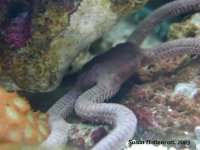from Academic Press Daily InSCIght, 7 MAY 1997
New Drugs from the Stars
Miami Beach--The brittle star, a long-armed relative of the starfish, has a remarkable ability to regenerate a severed limb without displaying any signs of infection. Now researchers know how it performs this infection-defying feat: Symbiotic bacteria living within the animal produce compounds that stifle potentially harmful
pathogens. These compounds might be potential candidates for antibiotic drugs. Marine physiologist Bill Dobson, of Appalachian State University in Boone, North Carolina, was intrigued by the brittle star's ability to withstand serious injury. "They never become infected, even though their environment is full of pathogens," Dobson says. On closer inspection, he discovered a thin layer of bacteria living between the brittle star's protective cuticle and inner skin layer. Dobson reported at the annual meeting of the American Society for Microbiology here that electron-micrograph pictures of a wounded brittle star revealed bacteria completely covering the wound within 1 to 2 hours after an injury. After swabbing the wounds, Dobson found 59 distinct assemblages of bacteria. Lab tests suggest that at least 10 species of bacteria may be living within the brittle star, says Eileen Stahl, a graduate student who works with Dobson. When Stahl grew these samples in petri dishes, most of them prevented growth of the bacteria responsible for pneumonia, staphylococcal skin infections, salmonella, diphtheria, and in some cases, anthrax. At least four samples completely killed many of the pathogens. Despite the initial success, the compounds face a long road to market as antibiotics. For starters, Dobson and his crew must identify the bacteria and the compounds they produce, says Peter McCarthy, head of biomedical research at the Harbor Branch Oceanographic Institution in Fort Pierce, Florida. The compounds would then have to be tested against infectious bacteria in living
organisms.






